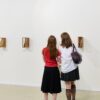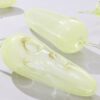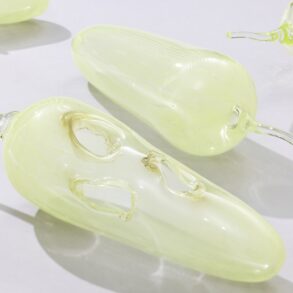The artistic American women who moved to Paris in the first four decades of the 20th century traveled there to change their lives. In the process, they changed much more than that. Their story is sumptuously illustrated by the National Portrait Gallery’s sweeping exhibition “Brilliant Exiles: American Women in Paris, 1900-1939.”
One well-known saga of Americans in Paris in those years is exactly what curator Robyn Asleson intends to counterbalance. In her catalogue essay, she writes that “focusing on the accomplishments and experiences of women brings into view a very different picture from that conveyed by the male-centered Lost Generation legend.”
Some of the subjects of this exhibition, it’s true, are known for their links to famous men. Bookseller Sylvia Beach published James Joyce’s “Ulysses” when no one else would, and author Gertrude Stein is represented in the show by a notable portrait painted by Pablo Picasso.
Yet Beach and Stein helped construct a world largely independent from men. As lesbians, along with more than a few of their fellow American expatriates, they were able to live women-centered lives in Paris that would have been improbable, if not impossible, in the United States. This freedom was facilitated by a privilege many of them shared: inherited wealth.
A smaller but no less significant contingent sought freedom in Paris not only from traditional female roles but also from American racism. Of these, the most celebrated is Josephine Baker, who began by dancing in exoticized “native” costumes at the Folies Bergère. She’s seen here in a vibrant Paul Colin print in which she wears one of her best-known outfits, simply a skirt of artificial bananas. After World War II, during which Baker joined the French Resistance, she took less stereotypical roles.
The exhibition is divided into eight sections, some of which overlap. The Black émigrés are divided between “The Stars of Montmartre Nightlife” and “Harlem’s Renaissance in Paris.” Sculptor and art patron Gertrude Vanderbilt Whitney, who founded New York’s Whitney Museum of American Art, appears in both “Modern Art and Modern Women” and “Dancer of the Future,” which spins around modern dancer Isadora Duncan.
In addition to the chapter devoted to Duncan, several other sections center on a single woman, such as Stein (and lover Alice B. Toklas) or writer Natalie Clifford Barney (and one of her lovers, painter Romaine Brooks). Barney’s celebrated salons may have been quintessentially Parisian, but they were modeled in part on the ones hosted by her mother, Alice Pike Barney, at the family’s home near Sheridan Circle in Washington. (The building is now the Embassy of Latvia.) The show’s painted portraits of Natalie and her sister, Laura, are by Alice.
Of the more than 60 women documented in this overview, not all became full-time Parisians. Writer Katherine Anne Porter lived there about four years, which is longer than Los Angeles-born Chinese American actress Anna May Wong. Loïs Mailou Jones, who spent most of her career at Howard University, studied in Paris for just a year, although she considered that sojourn a crucial influence. The three Jones paintings on display include a portrait of opera singer Lillian Evanti, a native Washingtonian who during the 1920s performed often in France but did not settle there.
The show’s chronology ends, understandably, in 1939. Yet some of these exiles stayed even after the Nazis arrived. Beach and Stein remained, and the former, like Baker, worked for the resistance. Stein, more problematically, supported the Nazi-collaborationist Vichy government. Also a fascist sympathizer for a time, Natalie Barney lived in Italy during the war but resumed her Paris salon in 1949.
The 77 artworks include photographs of Wong by Edward Jean Steichen; Black nightclub proprietor Ada “Bricktop” Smith by Carl van Vechten; Peggy Guggenheim (whose name ended up on more than one museum) by Man Ray; and several by Berenice Abbott, including a self-portrait. One of the most striking paintings is Alfred Courmes’s portrayal of Guggenheim, formally posed in front of a Renaissance-style landscape where an automobile offers the only clue as to what century it is.
Also a painter, Steichen produced the show’s centerpiece, three panels of the vast seven-panel “In Exaltation of Flowers.” The art nouveau-influenced tempera-and-gold-leaf picture of women posed in a stylized garden was made in 1901-1913 for Eugene and Agnes Meyer, who would purchase this newspaper in 1933.
Thematically, some of the sections cohere better than others. “Refashioning Modern Women,” encompassing Wong, Guggenheim, Anaïs Nin and others, is something of a grab bag. But perhaps the show shouldn’t be approached as a “counternarrative,” Asleson’s description of it. Maybe it’s better seen as an extension of Steichen’s “In Exaltation of Flowers,” a garden scattered with wild blooms.
Brilliant Exiles: American Women in Paris, 1900-1939
National Portrait Gallery, Eighth and F streets NW. npg.si.edu. 202-633-1000.
Dates: Through Feb. 23.
Prices: Free.
This post was originally published on this site be sure to check out more of their content







